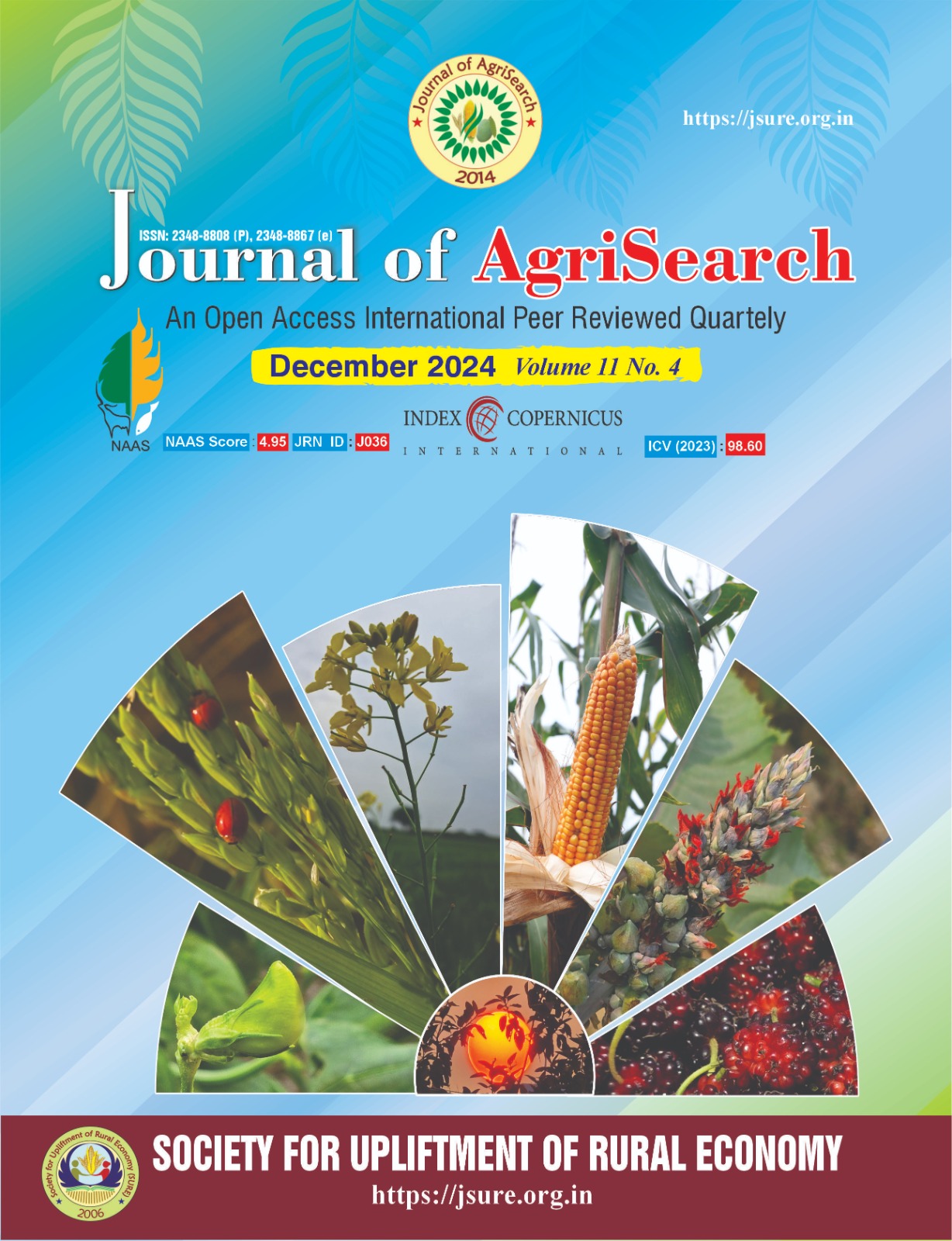Effect of micronutrients and NPK consortia on nodulation, yields and economics of chickpea (Cicer arietinum L.) in vertisols
Micronutrient & NPK effects on chickpea in vertisols
DOI:
https://doi.org/10.21921/jas.v11i04.15214Keywords:
Chickpea, Micronutrients, Nodulation, Consortia Productivity , Protein contentAbstract
The present investigation was carried to understand the effect of micronutrients and NPK consortia on nodulation, yields and economics of chickpea in vertisols. The experiment was laid out in randomized block design with three replications. The treatments involved in the study were eight in number, i.e., T1: Control, T2: Zn @ 5 kg/ha, T3: Zn @ 7.5 kg/ha, T4: Zn @ 7.5 kg/ha + 0.5% foliar spray of ZnSO4 at 30 DAS, T5: Zn @ 7.5 kg/ha + seed treatment with molybdenum @ 2 g/kg seed, T6: Zn @ 7.5 kg/ha + 0.5% foliar spray of ZnSO4 at 30 DAS + seed treatment with molybdenum @ 2 g/kg seed, T7: Zn @ 7.5 kg/ha + seed treatment with NPK consortia @ 10 ml/kg, T8: Zn @ 7.5 kg/ha + 0.5% foliar spray of ZnSO4 at 30 DAS + seed treatment with molybdenum @ 2 g/kg seed + seed treatment with NPK consortia @10 ml/kg seed. Results clearly indicates that application of Zn @ 7.5 kg/ha + 0.5% foliar spray of ZnSO4 at 30 DAS + seed treatment with molybdenum @ 2 g/kg seed + seed treatment with NPK consortia @10 ml/kg (T8) gave significant and positive effect on nodulation (total nodules, effective nodules, fresh and dry weight of nodules/plant) and yield parameters viz., pods/plant (72.88) and 100-seed weigh (23.10 g), seed yield (18.99 q/ha) and biological yield (37.06 q/ha) as compared to other treatments. Similarly, maximum protein content (21.25%), protein yield (40.23 t/ha), gross returns (Rs.100447/ha), net returns (Rs. 68856/ha) and B:C ratio (3.18) was also noted under T8 treatment. The chemical properties of soil (available N, P and K) also improved but not reached at significant level. Hence, application of 7.5 kg/ha + 0.5% foliar spray of ZnSO4 at 30 DAS along with seed treatment with molybdenum @ 2 g/kg seed and NPK consortia @10 ml/kg improved the nodulation, productivity as well as economics of chickpea under rainfed conditions.
References
A O A C. 1970. Association of official analytical chemistry. Methods of analysis, Washington DC 2044, 11th Ed.
Anonymous. 2023. Economic survey 2023-24, statistical appendix, Ministry of Finance, Government of India, production of important crops in three largest producing states.
Banjara G P and Majgahe S K. 2019. Effect of biofortification of zinc and iron on yield attributes and yields of chickpea (Cicer arietinum L.) through agronomic intervention. The Pharma Innovation Journal 8(10): 45-47.
Chandra G, Gambhir L, Upadhyay R. 2020. Effects of biofertilizer with and without molybdenum on growth and seed yield of chickpea under Doon valley of Uttrakhand. Current J. of Applied Science and Tech. 39(15): 133-139.
Gomez K A and Gomez, A A. 1984. Statistical Procedure for Agricultural Research, 2nd Edn. John Wiley & Sons, New York. pp. 241-271.
Katiyar N K, Mishra U S, Kumar V, Kumar A, Raizade S, Pathak R K and Pandey S B. 2017. Response of zinc, boron and molybdenum on growth, yield attributes and yield of chickpea (Cicer arietinum L.) under rainfed conditions. Research on Crop 18(1): 29-34.
Khandkar U R, Tiwari S C, Kumawat N, Ashok A K, Bangar K S, Singh S P. 2019. Effect of micronutrients, organics, and biofertilizers on growth and yield of soybean under vertisols. Journal of Experimental Zoology, India 22(1): 1433-1436.
Kumar R, Deka B C, Kumawat N, Ngachan S V. 2014. Effect of integrated nutrition, biofertilizers and zinc application on production potential and profitability of garden pea (Pisum sativum L.) in eastern Himalaya, India. Legume Research 37(6): 614-620.
Kumawat N, Kumar R, Khandkar U R, Yadav R K, Dotaniya M L, Mishra J S, Hans H. 2019. Silicon (Si) and Zinc (Zn) Solubilizing Microbes: Role in sustainable agriculture. Biofertilizers for sustainable agriculture and environment. B. Giri et al. (eds.), Biofertilizers for Sustainable Agriculture and Environment, Soil Biology 55, pp.109-135.
Kumawat N, Tiwari S C, Bangar K S, Khandkar U R, Ashok A K, Yadav R K. 2021. Influence of different sources of plant nutrients on soil fertility, nutrient uptake and productivity of soybean under vertisols. Legume Research 44(5): 556-561.
Kumawat N, Yadav R K, Singh M, Dudwe T S and Tomar I S. 2020. Effect of phosphorus and bioinoculants and their residual effect on succeeding chickpea (Cicer arietinum) cropping system. Indian Journal of Agricultural Sciences 90(2): 320-325.
Nandan B, Sharma BC, Chand G, Bazgalia, Kumar R and Banotra M. 2018. Agronomic fortification of Zn and Fe in chickpea an emerging tool for nutritional security - A global perspective. Acta Scientific Nutritional Health 2(4): 12-19.
Weisany W, Sohrabi Y, Heidari G, Siosemardeh A and Ghassemi-Golezani K. 2012. Changes in antioxidant enzymes activity and plant performance by salinity stress and zinc application in soybean (Glycine max L.). Plant Omics Journal 5(2): 60-67.
Downloads
Published
Issue
Section
License
Copyright (c) 2024 Deepika Chourey, kumawat, Yadav, patidar

This work is licensed under a Creative Commons Attribution-NonCommercial-NoDerivatives 4.0 International License.
Publisher and Authors

